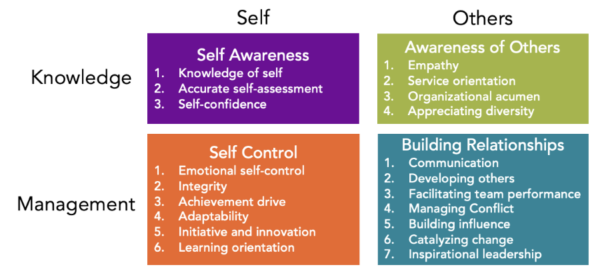

Emotional intelligence can often feel like an unnameable quality that people either seem to have or don’t — boiled down to terms like “charming,” “charismatic,” or being a “people person.” But actually, true EQ is definable, measurable, and most importantly, achievable.
Dr. Daniel Goleman discovered four components of emotional intelligence that form a matrix of your awareness and ability to manage both yourself and relationships with others. Within this matrix are 20 core competencies.

High self-awareness means having a strong understanding of yourself, including your values along with your strengths and weaknesses. Another element is that and your self perception aligns with how others perceive you.
The key to self-control is all about managing your emotions and acting in healthy and productive ways. Learning to regulate your emotions is vital as well as identifying when you are triggered and pausing before you speak.
This is where emotional intelligence moves out from the self toward others. An awareness of others means being conscious and understanding of others’ emotions and needs, and how to react accordingly. It also means being aware of their skills, preferences, and core aspects of their identity. In particular, the skill of empathy requires us to not only accurately read emotions in others but to identify a time when we have felt that same feeling.
Our ability to build relationships relies on our awareness of others in order to forge connections and relate to one another. Several critical competencies live here like communication and managing conflict. For leaders, they need strengths in developing others, building influence, and catalyzing change.
Building your capacity in each of these components will allow you to understand both yourself and others better. Consider these stats:
A common misconception is believing that EQ lies only in people’s emotions. But a key principle of EQ is understanding that emotion is information and that our brain utilizes this information to shape our thoughts and actions..
Research from neuroscience, psychology, and even anthropology shed light on how our brains were designed to be attuned to emotions. Understanding the three levels of the brain, and how they build upon each other in sophistication can allow us to access the deeper thinking parts of us rather than allowing our primitive brains to control us.
The base level of the brain, known as the reptilian or survival brain, is constantly scanning our environment for signs of danger. The amygdala is primed and ready to kick off the “fight-flight-freeze” response when activated by a trigger deemed potentially harmful. In physical situations, that rush of adrenaline and cortisol is what allows people to access superhuman strength to save others, or exceptional speed to outrun a danger.
But in social situations, these triggers and responses look different. The fight response can certainly manifest in physical aggression, but more often it shows up as behaviors like criticism, contempt, sarcasm, shaming, or teasing. Meanwhile, the flight and freeze response might look like fleeing or withdrawing, getting defensive, stonewalling, or blaming others. Understanding your own pattern of learned responses can help you identify which ones are truly necessary, and which are simply an unhealthy force of habit.
The middle layer of the brain is called the limbic, or emotional brain and is where core emotions like joy, anger, fear, sadness, and disgust live. This part supports our survival by helping us connect with others, care for our young, and navigate social groups. While the reptilian brain acts out of instinct, there is scanning and thinking happening in the limbic brain as it sorts and processes broad emotional categories like happiness, sadness, fear, etc.
The outer portion of the brain is our most sophisticated region, called the neocortex or thinking brain. This is where both EQ and IQ live, as the executive center conducts logical analysis and effective decision-making. In this region, more nuanced emotions can be experienced and interpreted, allowing us to increase our self-awareness and empathy for others.
These three regions are not independent of one another. For instance, when the amygdala triggers a fight-flight-freeze response, it shuts down the executive center, overriding our logic and self-awareness. This isn’t a design flaw. When in real danger, like a car accident for instance, this mechanism is what protects us from shock.
Unfortunately though, the amygdala is primitive and shaped by our own personal histories and traumas, which means our brains can mistakenly interpret something harmless as potentially dangerous. When that happens, it’s called an amygdala hijack, which can momentarily rob us of our self-awareness or ability to think logically. As a result, we may do things we regret later.
People with high EQs recognize when this is happening and use techniques to regulate their emotions before any damage is done.
The success of any organization depends on its collective emotional intelligence. An organization’s EQ is a reflection of the EQ of those in key leadership positions, so make necessary adjustments from the top down. EQ is a skill that can be learned and improved and investing in EQ training consistently yields a positive return on investment (ROI), even as high as 1000%.
Leaders need to intentionally work to increase the EQ of the organization. The following are strategies you can use to build a case for prioritizing EQ within your organization—rely on the support of other high-EQ individuals to push this initiative forward:
The world needs people who can lead with emotional intelligence. By understanding and putting into practice these essential skills, workplaces and organizations can reach their highest potential.
Brain Aware Training is the leading developer of brain science-based training programs that solve today’s workplace challenges. We harness the power of human biology to help people—and organizations—rise to their potential. Global organizations from all industries turn to us to design and deliver engaging classroom and online training to help their people learn, practice, and master the behaviors critical to their strategic success. We provide certification in our research-based models and award-winning learning solutions that drive sustained behavior change and measurable results.